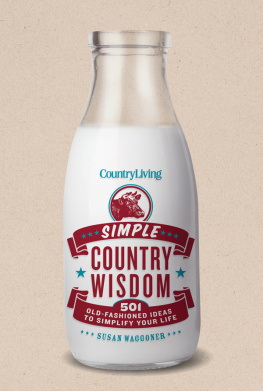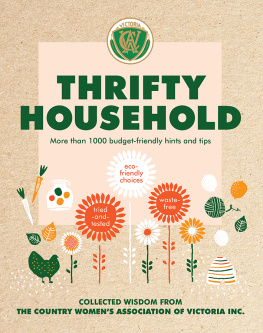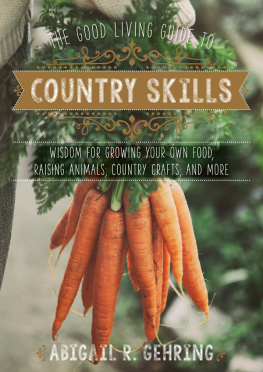


Copyright 2011 by Hearst Communications, Inc.
All rights reserved. The written instructions and photographs in this volume are intended for the personal use of the reader and may be reproduced for that purpose only. Any other use, especially commercial use, is forbidden under law without the written permission of the copyright holder.
Every effort has been made to ensure that all the information in this book is accurate. However, due to differing conditions, tools, and individual skills, the publisher cannot be responsible for any injuries, losses, and/or other damages that may result from the use of the information in this book.
This book was previously published as a hardcover.
Library of Congress Cataloging-in-Publication Data
Waggoner, Susan.
Country living : simple country wisdom / Susan Waggoner.
p.cm.
Includes index.
ISBN 978-1-58816-850-4
1. Home economics. I. Country living (New York, N.Y.) II. Title.
TX158.W343 2008
640dc22
2008018776
10 9 8 7 6 5 4 3 2 1
First Paperback Edition 2011
Published by Hearst Books
A division of Sterling Publishing Co., Inc.
387 Park Avenue South, New York, NY 10016
Country Living is a registered trademark of Hearst Communications, Inc.
www.countryliving.com
For information about custom editions, special sales, premium and corporate purchases, please contact Sterling Special Sales Department at 800-805-5489 or specialsales@sterlingpublishing.com.
Design: Anna Christian
Sterling ISBN 978-1-58816-850-4
Sterling eBook ISBN: 978-1-58816-916-7
CONTENTS
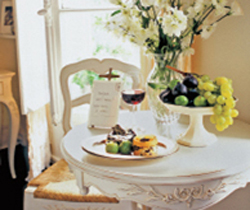
WHAT MAKES
A WELCOMING HOME?
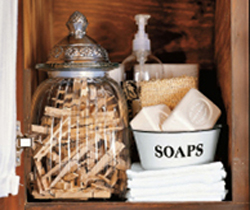
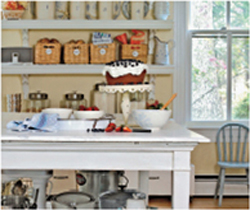
BETTER LIVING
THROUGH BAKING
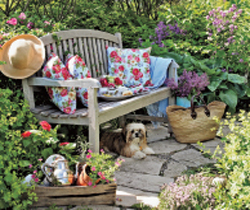
_________________________________
The opening words of Leo Tolstoys Anna Karenina strike an instant response in the heart of almost every reader: Happy families are all alike; every unhappy family is unhappy in its own way. We think not only of families we have known but of houses and homes themselves. A home is more than a collection of fabric and furniture, of rooms and walls and objects. It is a thing in itself, with a personality of its own and an aura that both reflects and influences all who come its way. Tolstoy might just as well have written, Happy homes are all alike; every unhappy home is unhappy in its own way, for that is how it seems to us.
As you can imagine, we spend a good deal of time seeing, thinking about, and knowing what makes a home specialthe kind of homes wed like to spend more time in, the kind of homes we like enough to invite Country Living readers into. Unhappy homes are like patients in a doctors waiting room, some with obvious ailmentsclutter or neglectand some with disturbances less obvious, like the home that looks just fine but is so aggressively orderly theres no space left for living. Happy homes, like Tolstoys happy families, all have a wonderful familiarity to them. They hum with energy and efficiency. They are not at war with those who live there, with a million tasks waiting at every turn, but glow with the promise of comfort and respite.
How to achieve this just-right harmony could be the study of a lifetime, for it isnt just a matter of having clean fresh sheets or an inviting guest roomits a matter of knowing how to have them with as little fuss and waste as possible, so you can spend the precious resource of time with your friends and family, and enjoy the art of living in a home thats in harmony with itself and its environment. Author Susan Waggoner, self-described student of old ways as well as new, has gathered the best of her knowledge to share here. Whether its a no-scrub trick to make bathroom faucets gleam, creating a garden guaranteed to attract birds and butterflies, or simple nocost ways to slash energy consumption, her tips will help us all to live in homes that are more efficient and less demanding, with less clutter and more room for all thats joyous in life.
The editors of Country Living


THE HOME
THAT
WELCOMES



What Makes a
Welcoming Home?

Where and how we live, what we do there, and how we embrace the space were given, is surely one of the worlds great themes. The Iliad may be about war, but the far greater Odyssey is about men who want nothing more than to get back to their wives, children, and vineyards. By the time she reaches the end of the Yellow Brick Road, Dorothy has no qualms at all about returning to a farm in Kansas. The Wind in the Willows Mole, enticed to set off on a wild adventure, begins to long for that little curtained world left behind.
Most of us have a home like this somewhere in our hearts. Its the home we try to create every day. Some days we do a good job of it, some days we fall behind. Often, theres a looming sense that we should be doing somethingor doing morethan we are, but we arent quite sure what it is.
Its a unique feature of the past few generations that many of us grew up in chore-free childhoods. Even the word chore has an old-fashioned ring to it. So do a few other words, like visit, front porch, and gracious plenty. Yet all of these words, and the things they represent, are part of that home we strive for, whether we know it or not.
PUTTING THE ELEMENTS TOGETHER
Over the years, weve kept the ideal but lost much of the knowledge of what it took to get there. My mother, the first woman in her family to work outside the home, never learned to bake breadthat was the point of college, after all. My grandmother never taught me because she assumed that baking bread was something everybody knew how to do. Eventually, I learned to bake bread on my own. And years later, my mother decided that bread was something she was interested in as well. Together, through the course of many trials and errors, we cloned the Swedish rye bread my grandmother had made so effortlessly. Retrieving that one little scrap of the past filled us with a profound sense of contentment. When I think of my mothers house, that day is the one I remember.

